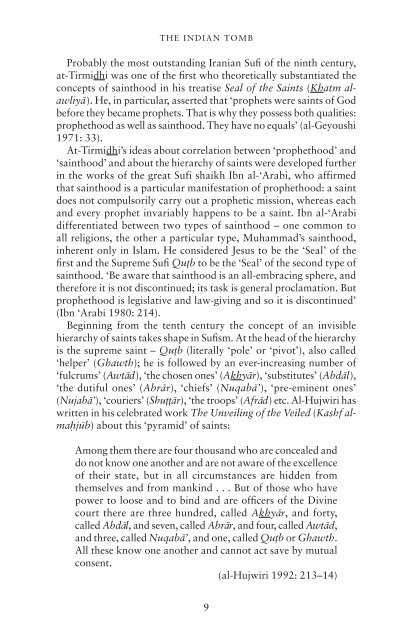Muslim Saints of South Asia: The eleventh to ... - blog blog blog
Muslim Saints of South Asia: The eleventh to ... - blog blog blog
Muslim Saints of South Asia: The eleventh to ... - blog blog blog
You also want an ePaper? Increase the reach of your titles
YUMPU automatically turns print PDFs into web optimized ePapers that Google loves.
THE INDIAN TOMB<br />
Probably the most outstanding Iranian Sufi <strong>of</strong> the ninth century,<br />
at-Tirmidhi was one <strong>of</strong> the first who theoretically substantiated the<br />
concepts <strong>of</strong> sainthood in his treatise Seal <strong>of</strong> the <strong>Saints</strong> (Khatm alawliyā).<br />
He, in particular, asserted that ‘prophets were saints <strong>of</strong> God<br />
before they became prophets. That is why they possess both qualities:<br />
prophethood as well as sainthood. <strong>The</strong>y have no equals’ (al-Geyoushi<br />
1971: 33).<br />
At-Tirmidhi’s ideas about correlation between ‘prophethood’ and<br />
‘sainthood’ and about the hierarchy <strong>of</strong> saints were developed further<br />
in the works <strong>of</strong> the great Sufi shaikh Ibn al-‘Arabi, who affirmed<br />
that sainthood is a particular manifestation <strong>of</strong> prophethood: a saint<br />
does not compulsorily carry out a prophetic mission, whereas each<br />
and every prophet invariably happens <strong>to</strong> be a saint. Ibn al-‘Arabi<br />
differentiated between two types <strong>of</strong> sainthood – one common <strong>to</strong><br />
all religions, the other a particular type, Muhammad’s sainthood,<br />
inherent only in Islam. He considered Jesus <strong>to</strong> be the ‘Seal’ <strong>of</strong> the<br />
first and the Supreme Sufi Quţb <strong>to</strong> be the ‘Seal’ <strong>of</strong> the second type <strong>of</strong><br />
sainthood. ‘Be aware that sainthood is an all-embracing sphere, and<br />
therefore it is not discontinued; its task is general proclamation. But<br />
prophethood is legislative and law-giving and so it is discontinued’<br />
(Ibn ‘Arabi 1980: 214).<br />
Beginning from the tenth century the concept <strong>of</strong> an invisible<br />
hierarchy <strong>of</strong> saints takes shape in Sufism. At the head <strong>of</strong> the hierarchy<br />
is the supreme saint – Quţb (literally ‘pole’ or ‘pivot’), also called<br />
‘helper’ (Ghawth); he is followed by an ever-increasing number <strong>of</strong><br />
‘fulcrums’ (Awtād), ‘the chosen ones’ (Akhyār), ‘substitutes’ (Abdāl),<br />
‘the dutiful ones’ (Abrār), ‘chiefs’ (Nuqabā’), ‘pre-eminent ones’<br />
(Nujabā’), ‘couriers’ (Shuţţār), ‘the troops’ (Afrād) etc. Al-Hujwiri has<br />
written in his celebrated work <strong>The</strong> Unveiling <strong>of</strong> the Veiled (Kashf almah˛jūb)<br />
about this ‘pyramid’ <strong>of</strong> saints:<br />
Among them there are four thousand who are concealed and<br />
do not know one another and are not aware <strong>of</strong> the excellence<br />
<strong>of</strong> their state, but in all circumstances are hidden from<br />
themselves and from mankind ... But <strong>of</strong> those who have<br />
power <strong>to</strong> loose and <strong>to</strong> bind and are <strong>of</strong>ficers <strong>of</strong> the Divine<br />
court there are three hundred, called Akhyār, and forty,<br />
called Abdāl, and seven, called Abrār, and four, called Awtād,<br />
and three, called Nuqabā’, and one, called Quţb or Ghawth.<br />
All these know one another and cannot act save by mutual<br />
consent.<br />
(al-Hujwiri 1992: 213–14)<br />
9


